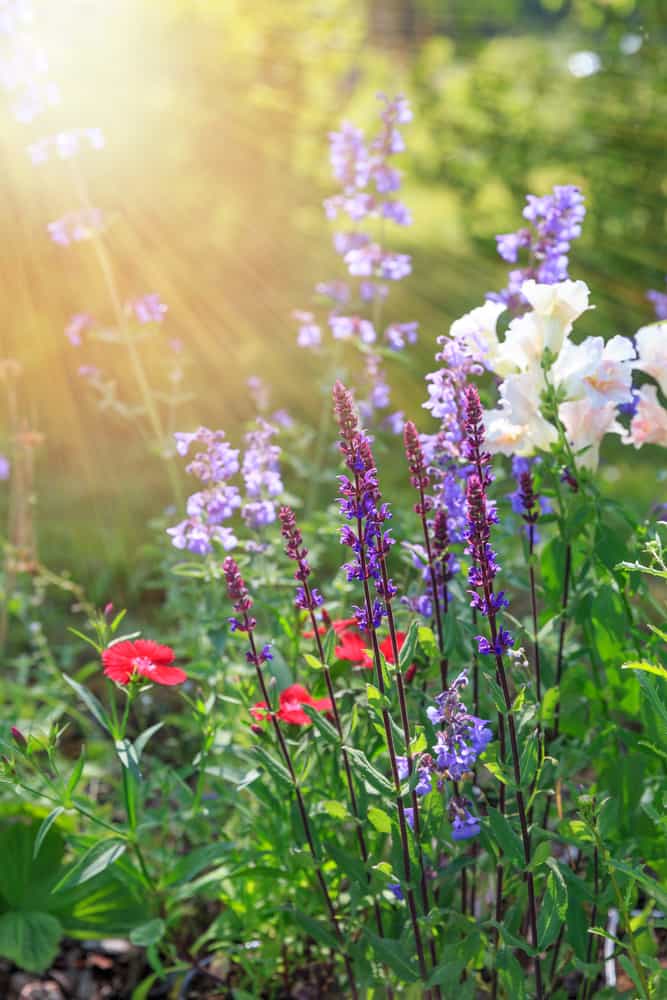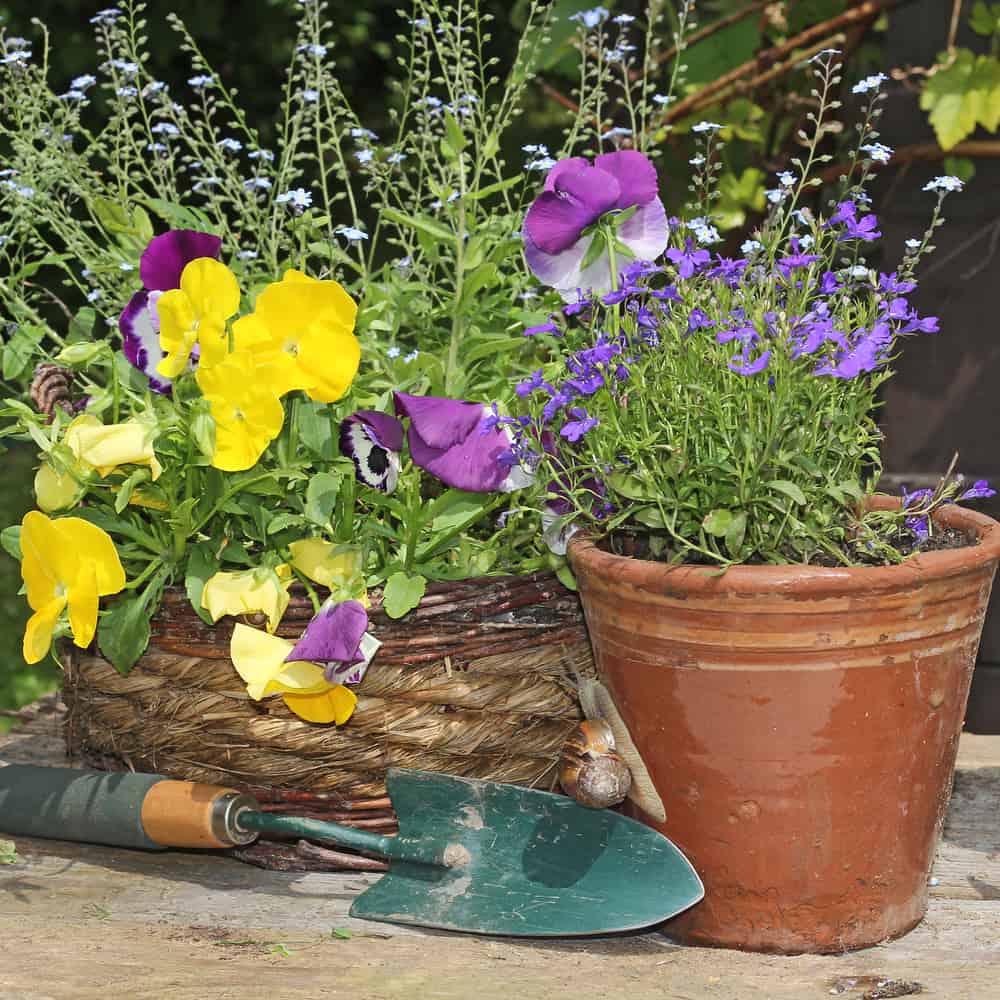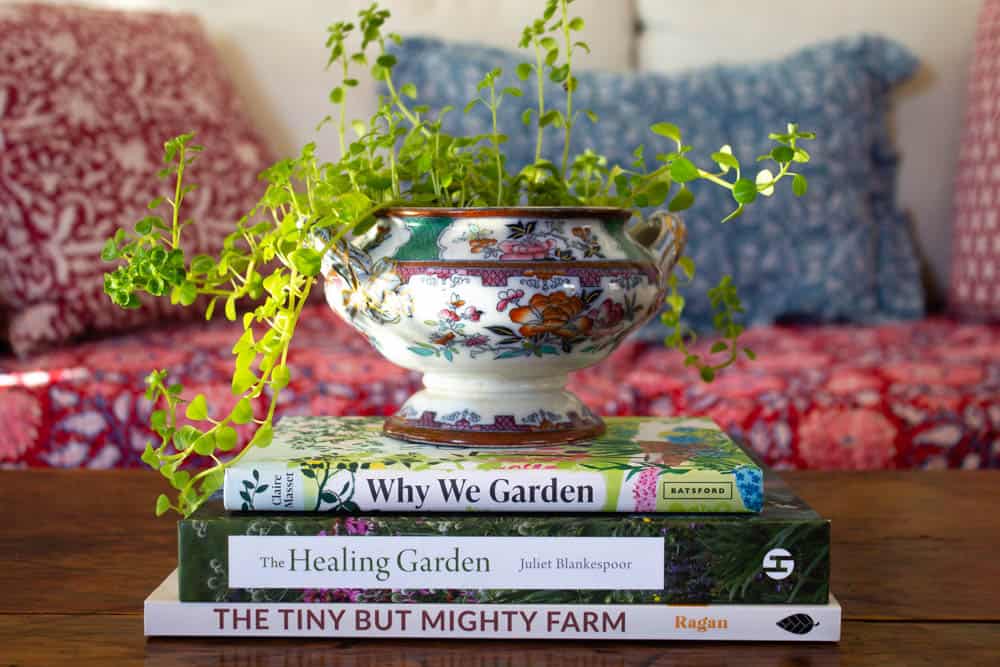
Are you dreaming of Spring Gardening yet? Around mid-February, I start to yearn for the fresh green shoots of spring to appear. Dreaming of spring is an anticipation of the vibrant colors, fragrant blooms, and aromas from fresh produce that come with the season.
What do you picture? How about rows of flourishing vegetables, beds filled with radiant flowers, or perhaps a cozy corner for relaxation surrounded by greenery? The promise of warmer weather, the scent of earth, and the joy of nurturing plants start to fill my mind with endless possibilities for a garden oasis.
In reality, I’m a very amateur gardener, albeit an enthusiastic one. My little cottage boasts a small round bed, which I planted with roses, lavender, and rosemary last year, and a small deck with plenty of containers of brightly colored blooms.

This year I’m ready to expand my repertoire. A variety of herbs, vegetables, and sun-loving flowers would be perfect. An English cottage garden on my small deck is really what I’m after.
What makes an English Cottage Garden?
To create an English cottage garden on my deck bringing in plants that create an informal, romantic, and wild style is key. A harmonious mix of flowers, herbs, and vegetables is the dream. Here are some picks that would be lovely to include:
- Roses: No English cottage garden would be complete without roses. Old-fashioned varieties like David Austin roses (see below) or climbing roses draped over trellises and arbors add charm and fragrance to the garden.
- Lavender: With its fragrant blooms and silvery foliage, lavender is a staple in cottage gardens. It’s not only beautiful but also attracts pollinators like bees and butterflies.
- Delphiniums: Tall spikes of blue, pink, or white flowers make delphiniums a striking addition to the cottage garden. They add height and drama to flower borders.
- Foxgloves: These tall, elegant biennials produce spires of tubular flowers in shades of pink, purple, or white. They self-seed readily, adding a natural, cottagey feel to the garden.
- Climbing Plants: Climbing plants such as clematis, honeysuckle, and jasmine are often trained to grow up walls, fences, or trellises, adding vertical interest and fragrance to the garden.
- Herbs: Culinary and medicinal herbs like thyme, sage, rosemary, and mint are not only useful but also add texture and fragrance to the garden. They can be tucked into flower borders or grown in dedicated herb beds.
- Hollyhocks: Tall spikes of colorful flowers make hollyhocks a classic cottage garden favorite. They come in a range of colors, including pink, red, yellow, and white.
- Daisies: Shasta daisies, ox-eye daisies, and other daisy-like flowers add a cheerful, cottagey vibe to the garden. They’re easy to grow and attract pollinators.
- Sweet Peas: Fragrant and delicate, sweet peas are beloved for their colorful, ruffled blooms and sweet scent. They’re often grown along fences or trellises.
Doesn’t that sound idyllic! How about you? Do you have dreams of an English Cottage Garden? What’s your style and what are your garden dreams?
Sowing Seeds or Buying Plants – What’s Best to Start the Garden?

Deciding whether to sow seeds or buy plants for your spring garden can depend on the time you have available and the specific plants you want to grow. There’s no denying there’s something magical about watching your little seedlings grow! Here are some considerations for each option:
Sowing:
- Variety: Sowing seeds allows you to choose from a wider variety of plants. You can select specific cultivars, heirloom varieties, or unusual plants that may not be readily available as seedlings.
- Cost: Seeds are generally more economical than buying established plants. You can purchase packets of seeds for a fraction of the cost of buying individual plants.
- Control: Starting plants from seeds gives you greater control over their growth from the very beginning. You can ensure they receive the proper care, including watering, fertilizing, and monitoring for pests and diseases.
- Learning Experience: Sowing seeds can be a rewarding learning experience, especially for beginners. It offers an opportunity to observe the entire lifecycle of a plant, from germination to maturity.
- Timing: Some plants, particularly vegetables, benefit from being started from seed indoors before being transplanted outdoors. This allows you to extend the growing season and get a head start on the warmer weather.
Buying:
- Convenience: Buying established plants can be more convenient, especially if you have limited time or space for starting seeds indoors. You can simply purchase the plants you want and transplant them directly into your garden.
- Instant Gratification: With seedlings, you’ll see results more quickly since they are already established and growing. This can be particularly appealing if you’re eager to enjoy blooms or harvests sooner rather than later.
- Risk Management: Buying plants can be less risky than starting from seeds, as you’re obtaining plants that have already survived the delicate early stages of growth. This can be advantageous if you live in an area with a short growing season or challenging climate conditions.
- Selection: While seeds offer a wide variety, buying plants may provide access to specific cultivars or varieties that are not commonly available as seeds.
My Favorite Seed Company for Your Spring Garden
I’ve had great luck with Johnny’s Selected Seeds they have an AMAZING variety of fruits, vegetables, and flowers. Just receiving their catalog in the mail is exciting 🙂
My Favorite Roses

My absolute favorite rose company is David Austin Roses. They are truly stunning. I purchased 3 Princess Alexandra of Kent bushes last spring and they were glorious. Sadly, the deer also loved them. I counted 15 buds one evening and the next morning they had been eaten. I nearly cried. Happily, they grew back and bloomed 🙂
While Dreaming of Spring Gardening enjoy Clare Foster’s Traditional English Garden Tour
Dreaming of Spring Gardening Reading!

The following are delightful reads:
- The Tiny But Mighty Farm by Jill Ragan This very practical and inspiring book is allowing me to dream big about my small deck!
- The Healing Garden by Juilette Blankespoor. A beautiful book and a must-have if you’re considering growing herbs and learning about herbalism.
- Why We Garden by Clare Masset A delightful read about the mystery of what makes us love gardening, via history, science, art, and philosophy.

Hello i think that i saw you visited my weblog so i came to Return the favore Im trying to find things to improve my web siteI suppose its ok to use some of your ideas